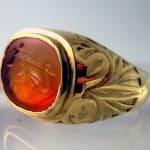Gold Ring with a Roman Orange Carnelian Intaglio Depicting a Chariot Drawn by a Bird, 100 CE - 300 CE
Gold and Carnelian
FJ.6588
The art of glyptics, or carving on colored precious stones, is probably one of the oldest known to humanity. Intaglios, gems with an incised design, were made as early as...
The art of glyptics, or carving on colored precious stones, is probably one of the oldest known to humanity. Intaglios, gems with an incised design, were made as early as the fourth and third millennia B.C. in Mesopotamia and the Aegean Islands. The exhibit a virtuosity of execution that suggests an old and stable tradition rooted in the earliest centuries. The tools required for carving gems were simple: a wheel with a belt-drive and a set of drills. Abrasives were necessary since the minerals used were too hard for a metal edge. A special difficulty of engraving intaglios, aside from their miniature size, was that the master had to work with a mirror-image in mind.
Although we generally associate chariots with horses, this was not always the case. However, the bird that pull the chariot engraved on this seal are not just impractical, but simply fantastical. Yet, mythology often veers into the realm of fantasy. The chariot of the sun god Apollo was pulled by winged horses while the sea god Neptune rode in a chariot pulled by sea horses. This bird might be a pheasant or perhaps an ostrich. One need just to look at the driver of this chariot, the winged goddess of victory, Victoria, to realize this in no ordinary scene from a chariot race. In antiquity, such an intaglio might have been given to a champion charioteer by the emperor or another wealth admiring fan. During the Ancient Roman Empire, the popularity and wealth of chariot drivers was equal to that of professional athletes today. Surely this seal would have made a fitting present for a driver. Today, this seal, mounted in a gorgeous gold ring, is a potent symbol of success. We should all be so lucky to have paths guided by victory.
Although we generally associate chariots with horses, this was not always the case. However, the bird that pull the chariot engraved on this seal are not just impractical, but simply fantastical. Yet, mythology often veers into the realm of fantasy. The chariot of the sun god Apollo was pulled by winged horses while the sea god Neptune rode in a chariot pulled by sea horses. This bird might be a pheasant or perhaps an ostrich. One need just to look at the driver of this chariot, the winged goddess of victory, Victoria, to realize this in no ordinary scene from a chariot race. In antiquity, such an intaglio might have been given to a champion charioteer by the emperor or another wealth admiring fan. During the Ancient Roman Empire, the popularity and wealth of chariot drivers was equal to that of professional athletes today. Surely this seal would have made a fitting present for a driver. Today, this seal, mounted in a gorgeous gold ring, is a potent symbol of success. We should all be so lucky to have paths guided by victory.



